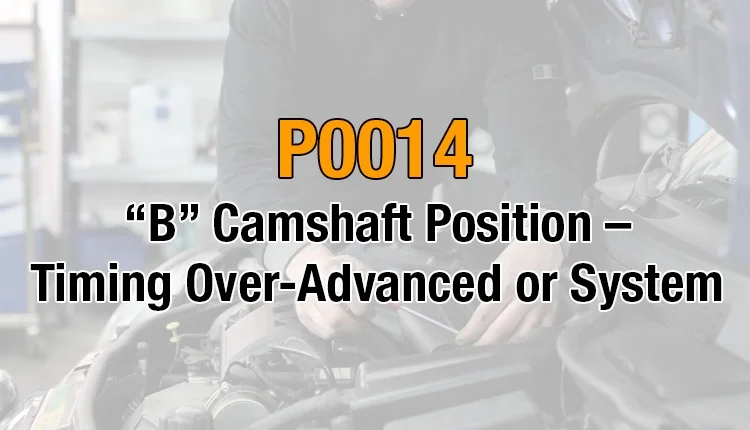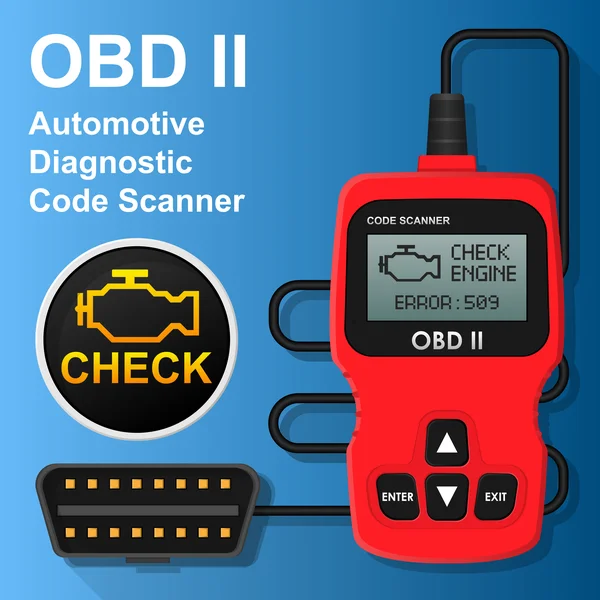P0014 – “B” Camshaft Position – Timing Over-Advanced or System
The P0014 OBD2 code tells you the timing of your engine is off. It specifically points you to the B camshaft on bank 1, making this code easier to diagnose than many OBD2 trouble codes. This code can typically be fixed by replacing a valve or solenoid. It may also be an indication that you’re using the wrong kind of oil. Read on to find out how to diagnose and repair this code correctly.
P0014 Code Definition
P0014 Code Definition (Generic): “B” Camshaft position – timing over-advanced or system performance (Bank 1)
P0014 Equinox (Chevy) Code Definition: Camshaft Position B – Over Advanced – Bank 1 (common)
P0014 Hyundai Code Definition: Camshaft Position B – Over Advanced – Bank 1 (common)
P0014 Kia Code Definition: “B” Camshaft position timing over-advanced
P0014 Peugeot Code Definition: “B” Camshaft position timing over-advanced
P0014 Trailblazer (Chevy) Code Definition: Camshaft Position B – Over Advanced – Bank 1 (common)

What Does P0014 Mean?
The P0014 OBD2 code indicates that the timing of your exhaust camshaft is too advanced. Your engine doesn’t operate the same way all the time. The engine control unit varies the valves’ timing, pistons, and other components depending on how much the engine is revving. Each component has an associated sensor that sends information to the ECU. The ECU then uses this data to determine when to power certain systems and how much power to send them. The goal is to keep the engine running as smoothly and efficiently as possible, with minimal emissions. If the ECU detects that the B camshaft on bank 1 has advanced more than it should, the P0014 trouble code will activate. Bank 1 is the side of the engine that contains cylinder 1. Depending on your vehicle, the B camshaft could be called the rear camshaft, the right camshaft, or the exhaust camshaft.
What Are The Symptoms Of The P0014 Code?
The symptoms of this code can change based on the position of the camshaft when it became over-advanced. Some common symptoms include:
- Activation of the check engine light
- Engine is hard to start
- Engine idles rough or stalls while idling
- Increased fuel consumption
- Increase in harmful emissions
What Are The Causes Of P0014 OBD2 Code?
Two systems could be the origin point of P0014: The camshaft and its components or the oil system. Specific causes include:
- Failure of camshaft variable timing solenoid
- Bad timing in camshaft
- Faulty wiring in the intake timing system
- Stuck or faulty camshaft phaser
- Short in the oil control solenoid
- Excessive oil viscosity
- Clogged passages around the camshaft phasers
How Serious Is The P0014 OBD2 Code?
The drivability issues associated with P0014 can cause further damage to your engine if allowed to go on for too long. While it is not unsafe to drive with this code active, you should repair it as soon as possible to avoid additional complications.
How To Diagnose The P0014 OBD2 Code

More often than not, the P0014 OBD2 code results from a mechanical failure in your engine. You should check your vehicle’s manual for suggestions before beginning your diagnosis. This trouble code often has specific fixes depending on what kind of car you drive.
Tools You’ll Need:
Method:
- Scan your system for other trouble codes. If you detect related trouble codes like P0010, P0011, P0012, P0020, P0021, or P0022, diagnosing those could help you identify the specific problem.
- Inspect the wiring and solenoids around the oil control valve and bank 1 B camshaft. Replace any that are frayed or damaged, and ensure all connections are secure.
- Check the level and viscosity of your oil. Your vehicle’s manual should contain information on the correct viscosity for your system.
- Use an OBD2 scan tool to read the live freeze frame data for the bank 1 B camshaft. Disconnect the oil control valve connected to the camshaft. If the valve is functional, the data should change. If it doesn’t, the valve should be replaced.
- Find the cam phaser and inspect it for sludge or damage. Also, inspect the oil passages around the camshaft phasers for build-up.
Common Mistakes To Avoid While Diagnosing The P0014 OBD2 Code
Some people replace their sensors before checking to see if there’s a mechanical problem. P0014 is rarely electrical in nature. Run a full diagnosis before you replace any components.
What Should You Do To Fix The P0014 OBD2 Code?
Use an OBD2 scan tool to clear the trouble codes after each repair, then conduct a test drive to see if they recur. While this might seem tedious, it will prevent you from making unnecessary fixes and is the best way to identify the root cause definitively.
- Replace any damaged wires or solenoids found in your diagnosis.
- If your oil is old, dirty, or too thick, you should replace it. Drain the oil, then replace the oil filter. If you noticed deposits clogging the oil passages, flush the system before adding new oil.
- Replace the cam phaser if it’s dirty or damaged.
- Replace the oil control valve if it failed the freeze-frame test in step 4 of the diagnosis.
- If none of these fixes clear the code, the problem is likely an electrical malfunction in the engine control unit. Take your vehicle to a mechanic for further diagnosis.
Tips To Avoid P0014 OBD2 Code In The Future
More often than not, this problem is the result of a dirty engine. The best way to avoid problems with your camshaft timing is to prevent sludge and other deposits from accumulating in the first place. You can take a few easy steps to keep your engine clean:
- Drive your engine hard. Getting your engine hot is the best way to remove deposits from your system. This naturally happens if you do a lot of fast driving, so engine build-up is more common for cars mostly driven in cities. When your engine starts feeling sluggish, go out on the highway and push your engine harder than usual for a few miles.
- Use the right oil. A high-quality oil of the correct viscosity will keep your system running its best.
- Replace your oil regularly. The older your oil, the less effective it is at lubricating your system. Any dirt or debris in the oil can also stick to components and clog them. Make sure to change your oil as soon as your car is due.
Read more: P0303 Code: Meaning, Symptoms, Causes, Diagnostics, and Fixes
